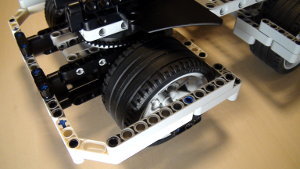

Как да следваме инструкции за построяване на робот
Ще построим лесния робот EasyBot и ще ви обясним как да следвате инструкции.
- #323
- 15 Jan 2017


Ще построим лесния робот EasyBot и ще ви обясним как да следвате инструкции.


In the video we improve on the robotics mechanism for pushing the different blocks out of the robot container. We continue from the previous video.


Играта "Развален телефон" с LEGO роботи разчита на сензора за цвят, но понякога той не работи както трябва. Сензорите за цвят може да бъдат повлияни от много външни фактори като позицията му и светлината в стаята. Този урок демонстрира как да се съобразим с тези фактори и да решим проблемите възникнали от тях.


In this video we look at the robotics mechanism for dropping the different blocks into the different region on the World Robotics Olympiad 2013 field.


All worked as expected, up until know because the robot got lost. This happens when we turn right and the line does not continue to the right. Now the robot must somehow understand that it is "lost" and escape.


After several questions about the use of the LEGO Mindstorms NXT Light Sensor with the EV3 software, we have decided to go through this problem in this video tutorial and pay special attention to the Raw Sensor Value Block.

Sometimes you could just throw a ball from base and solve a competition. Or at least many teams think so. In this video we would explore a very simple attachment for throwing balls from base. Can you use this for other missions? - we think so. Check out the video.


We continue from part 4 where we made a controlled experiment to transfer power from a Mindstorms motor to the rear wheels. The construction was too complex and inefficient and in this video lesson we are improving it by lowering the differential and removing all gear wheels from this LEGO Mindstorms EV3 Competition robot.


Extend the previously build attachment for the FIRST LEGO League (FLL) Nature's Fury competition so that we can move the Truck and Ambulance up and down.


Sometimes when we are working with sensors it is important that the time between two consecutive samples is the same. This will make each sample equally important and independent of how much time it took to take it. In this video tutorial, we would use the EV3-G timer block to make a "WaitForTick" program where the time between each sample of the EV3 Gyro takes exactly 0.02 seconds.


We continue from part 3 where we finished part of the 'rear'. Power is transfered from a motor to the wheels but having about 16 gear wheels makes it more than complex for this LEGO Mindstorms EV3 Competition robot.


It has been a long road with the last 8 BigDaddy competition robots video tutorials, but we finally arrived at the Differential Lock.


Има няколко основни правила, които според нас е добре да спазвате, докато подготвяте този курс. Нека ги разгледаме.


Arriving at a final solution. There is still room for improvement on using the Mindstorms Ultrasonic Sensor for aligning to walls, but we hope the whole five videos could give you a good idea of how to start with a problem and reach a solution.


In the final video we explore how to trigger the release of the attachment with just a rubber band. The release is triggered with a gear wheel that rotates in a specific way. This saves speed, does not require additional LEGO Mindstorms motor and is precise enough for a competition.

Based on a request from Abdulah we decided to build a tutorial on how to use Hi Technic Color Sensor and EV3-G Software. There is a special block imported in the software that helps you use the sensor.

Next robot construction for holding and releasing balls from this container. In this video we discuss the improvements and how to use the chains to release one ball at a time.

Part three of the Catapult series is about loading the catapult automatically. We use a gear system with a medium complexity along with a very interesting "clutch" developed with parts entirely from the LEGO Mindstorms NXT kits. As a result, at the end of the video, the Catapult automatically loads and fires.


We discuss the state of "Lost" and the different ways we could escape this state. We also build the next step of our State machine programming pattern where the next state is determined by the previous state.


One of the most interesting challenges in the series of FLL Competitions. Move a block and add additional floor on top of the block without damaging the construction. In this tutorial we would focus only this mission and we would achieve two movements with only one motor which makes the attachment quite powerful.


Based on a request we are showing the robot construction with two rear motors instead of a differential. In this way, as a construction, it is closer to more students, but much more challеnging for programing.

In this episode we do a full run of the mission for collecting a single treasure before going into explanation on how we have programmed the robot.

Collect the humans and clear them from the rocket launching region. This is rather straightforward as a task, but it requires a little bit of thinking if you want to do it without manipulators.


In this tutorial, we would implement a program that finds the minimum and maximum value detected by the sensor and stores this two values in an array.

Implementing the next logic for aligning to the border when we approach the border from the right.

Motors can be placed in opposite directions... opposite .. directions. Robo-builders might have difficulties imagining it so we have build one. One of the motors facing forward, the other backward. It is interesting how this robot turns.

В това видео ще покажем как се строи Петминутният робот и ще го прегледаме накратко.